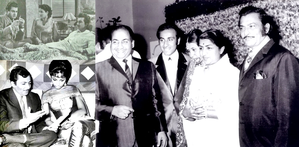New Delhi: Those witnessing the shooting of supernatural thriller “Woh Kaun Thi” in Shimla must have been taken aback when it came to its signature song “Naina barse rimjhim”. Sadhana was exquisite and eerie as she lip-synched the evocative song of love beyond lifetimes around an entranced Manoj Kumar, but the voice, striking and lyrical, was of a male!
It was music director Madan Mohan lending his voice, instead of the designated (female) singer, who could not be present, so that the shooting could be wrapped up. That made him the only male singer to have substituted for Lata Mangeshkar.
He had wanted to be a singer but became a music director – and in the full sense of the word, for his ability to seamlessly combine his tunes with the songwriter’s words and the singer’s voice to create eternal melodies. These were not confined to his quarter-century-long career but even manifested themselves decades after he passed away in 1975.
Some of his unused compositions, dug out by his son Sanjeev Kohli at Yash Chopra’s insistence and slightly revised, struck magic in “Veer-Zaara” (2004), earning him a posthumous Filmfare Award nomination.
However, he did not win – like in his lifetime.
That was the tragedy of Madan Mohan, the unquestioned “Prince of Ghazals” and many other intricate compositions, for he appealed more to connoisseurs than swaying the ultimate arbiters – the common cinema-goers. Even Lata Mangeshkar, who benefitted the most from him, confessed that she found his compositions hard to master.
His chosen path meant he never enjoyed the same opportunities and popularity as his contemporaries and got trapped in a vortex of despair, disillusionment, and drink that caused his death at just 51.
Born in Baghdad on this day (June 25) in 1924 – making this year his birth centenary – Madan Mohan did not enter filmdom automatically though his father, Rai Bahadur Chunnilal Kohli, was co-owner of Filmistan Studios. He deferred to his father’s wishes by joining the Army in 1943 amid the Second World War. However, soon after the war, he resigned to return to his prime love – music.
With his imposing physique – due to his army stint and regular workouts, his Clark Gable-like looks, and charm, he could have a star. He did get a lead role in a film but it was canned after a few reels were shot while doing small roles in Dilip Kumar-starrer “Shaheed” (1948), and Dev Anand-starrer “Munimji” (1954).
He also recorded two duets with Lata Mangeshkar for “Shaheed” but they were not used in it.
It was as a music director – after stints with All India Radio in Lucknow – where he befriended Ustad Faiyaz Khan, Ustad Ali Akbar Khan, Begum Akhtar, and Talat Mahmood – and Delhi, that he made his mark.
His first score was for “Aankhen” (1950) – though it was “Bhai-Bhai” (1956) became his first hit. Its “Qadar jaane na”, sung by Lata, so impressed Begum Akhtar when she heard it on radio that she called Madan Mohan long distance and made him sing it to her over and over again “for 18 or 22 minutes”, as she revealed in an interview.
There is also a story that once maestro Bade Ghulam Ali Khan was singing when the same song was heard on a nearby radio and he stopped right there, observing that this was perfect music.
Madan Mohan gave music for 90-odd films, with gems like “Zaroorat hai, zaroorat hai” (“Manmauji”, 1962), “Lag ja gale” (“Woh Kun Thi”, 1964) “Jhumka gira re” (“Mera Saaya”, 1966), haunting patriotic dirge “Kar chale ham fida jaan-o-tan sathiyon” (“Haqeeqat”, 1964), “Teri aankhon ke siva duniya mein” (“Chiraag”, 1969), “Ye duniya ye mehfil”, (“Heer Ranjha”, 1970), “Baiyan na dharo” (“Dastak”, 1970), “Ye maana meri jaan” and striking “Tum jo mil gaye ho” with its tune changes, (“Hanste Zakhm”, 1973), and his swan song “Dil dhoondhta hai” (“Mausam”, 1975) standing out.
However, it was the filmi ghazals, like “Yun hasraton ke daag” (“Adalat”,1958), “Rang aur noor ki baraat” (“Gazal”, 1964) or especially “Phir wohi shaam, wahi gham” (“Jahan Ara”, 1964), that were his main strength.
Maestro Naushad, akin to Ghalib offering to exchange his whole oeuvre for one couplet by Momin, said he was ready to forsake all his musical legacy for “Hai isi mein pyaar ki abru” from “Anpadh” (1962).
In “Anpadh”, Madan Mohan also displayed his flair for challenges. A song, featuring Lata, was to be shot when lyricist Raja Mehdi Ali Khan – Madan Mohan’s favourite along with Rajinder Krishan – dropped in and announced he had a new song. Director Mohan Kumar was so taken by it and so was Madan Mohan, who retired to a room and in minutes, came out with a fresh tune.
The substitute was the evergreen “Aapki nazron ne samjha”.
(Vikas Datta can be contacted at vikas.d@ians.in)
–IANS


Comments are closed.